reference material
STL Usage Summary
Basic concepts of STL
Basic components
| name | explain |
|---|---|
| Container | Holds an object that contains a set of elements |
| iterator | Iterators are generalized pointers that provide access to each element in a container |
| Function object | Objects that behave like functions, header files < functional > |
| Algorithms | Widely used for different objects and built-in data types, header file < algorithm > |
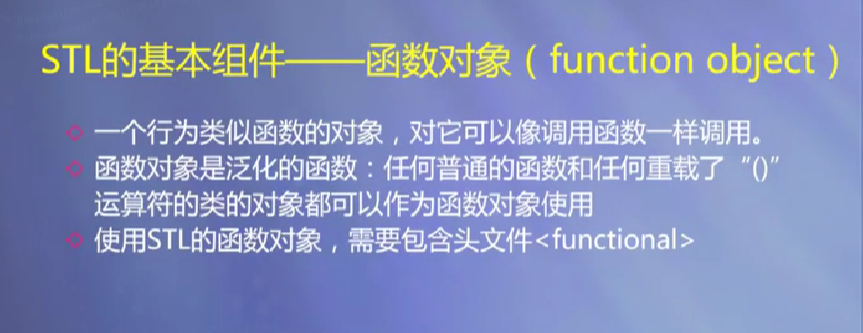

(1) Container
An object that contains a set of elements
a. Container classification
| Container template | give an example |
|---|---|
| Sequential container | array, vector, deque, forward_list (single linked list), list (list) |
| Ordered Association container | set, multiset, map, multimap |
| Unordered Association container | unordered_set (unordered), unordered_multiset, unordered_ Map, unordered_multimap (unordered Multimap) |
b. General functions of containers
| Function name | Functional interpretation |
|---|---|
| begin()end() | Get container head and tail iterators |
| clear() | Empty the container |
| empty() | Check whether the container is empty |
| size() | Get the number of container elements |
| s1.swap(s2) | Exchange the contents of s1 and s2 containers |
Related data types
S::iterator: iterator type pointing to the container element
S::const_iterator: constant iterator type
c. Sequential container
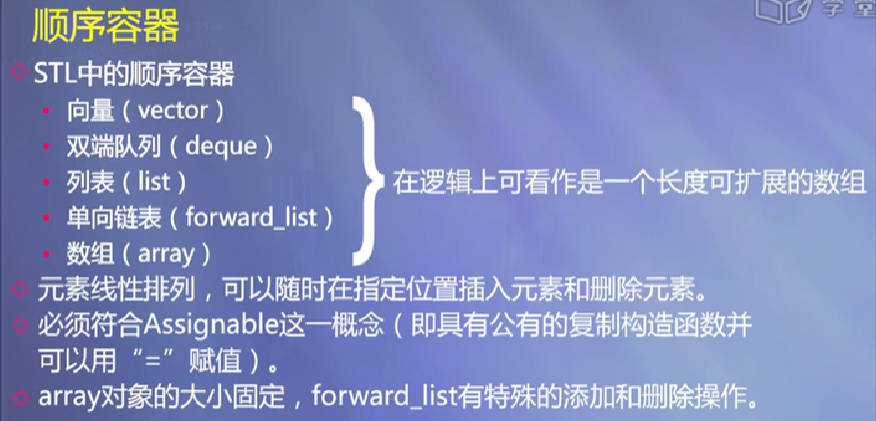
Some basic functions of sequential containers
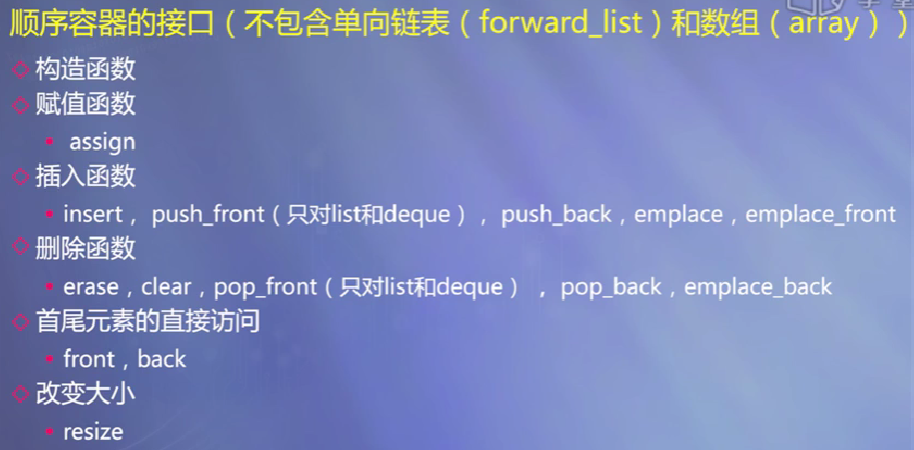
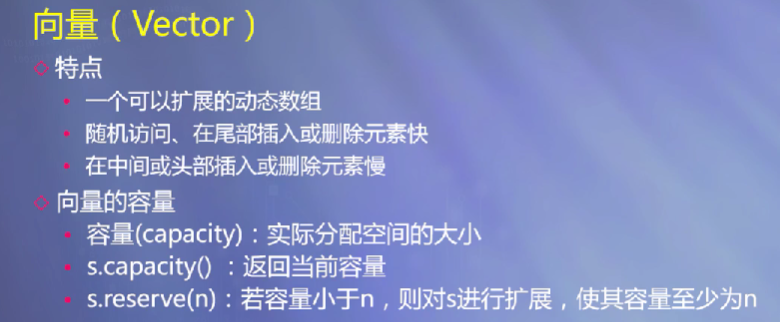



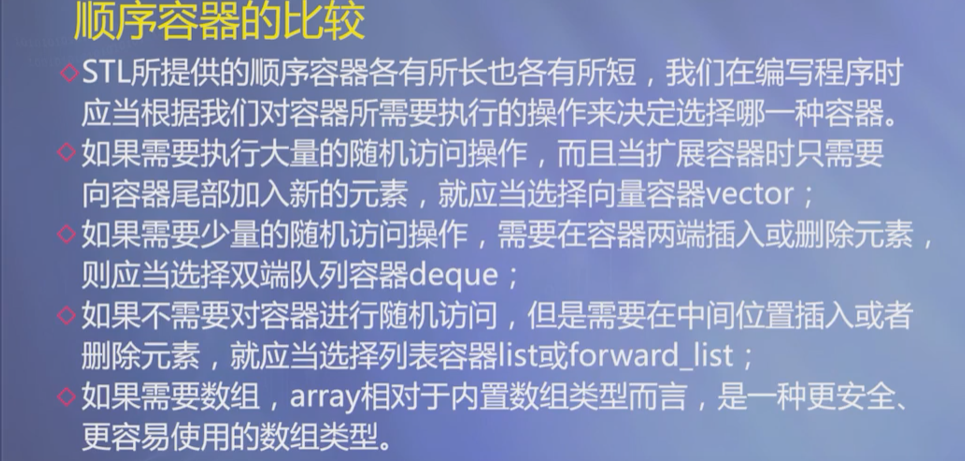

Operations supported by stack and queue
| Operation name | Functional interpretation |
|---|---|
| s1 op s2 | op can be = =,! =, < =, >, >= |
| s,size() | Returns the number of elements in s |
| s.empty() | Returns whether s is empty |
| s,push(t) | Press element t into s |
| s.pop() | Pop up an element from s. the last element pushed in is popped out of the stack, and the queue is the first element pushed in |
Stack and column operations are different
Stack: s.top() returns the reference of the top element of the stack
Queue: s.front() gets the reference to the header element; s.back() gets a reference to the end of the queue element
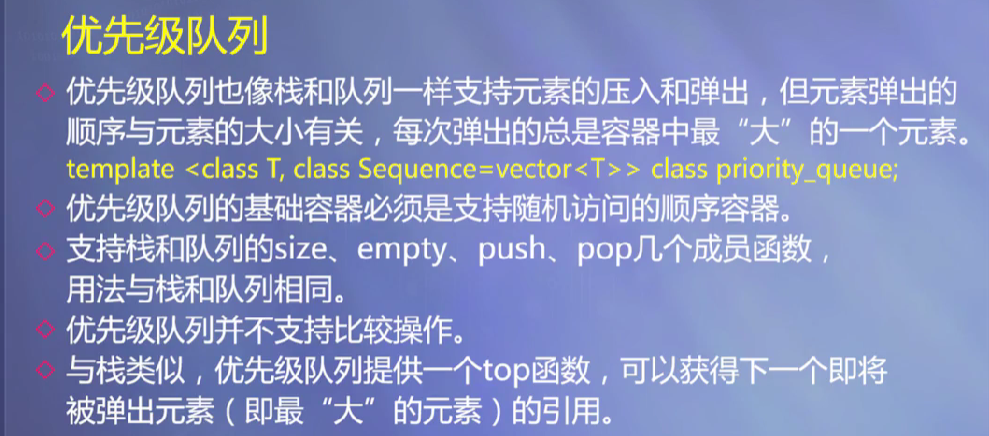
d. Associated container
Features: each associated container has a key
You can efficiently find elements based on.
Interface: insert delete find lower_bound, upper_bound, equal_range count
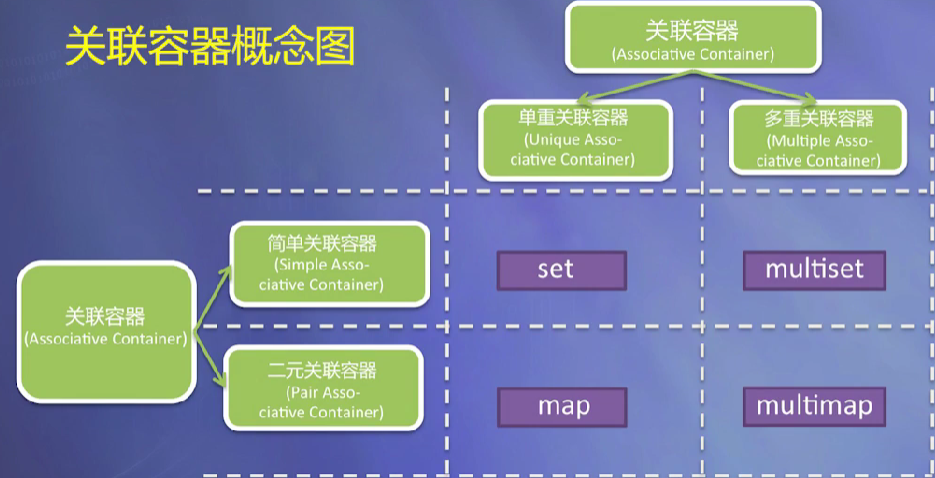
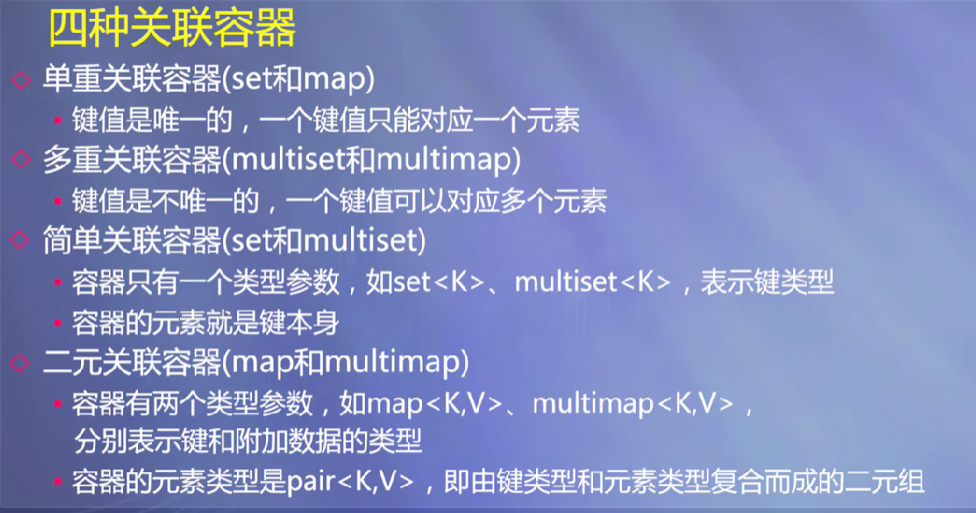
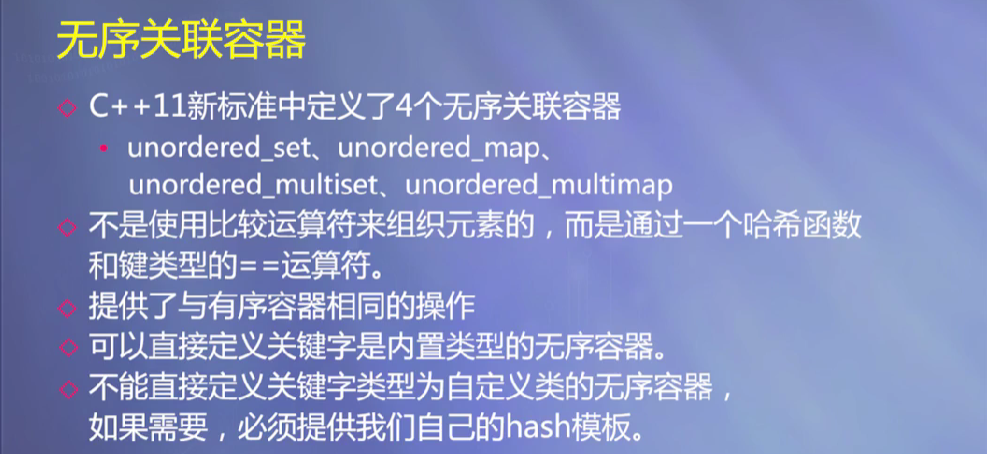
Collection: used to store a set of non repeating elements. The set element itself is ordered, which can efficiently find the specified element and conveniently get the interval of the specified element in the container
Tail iterator, pointing to the next position in the collection
eg: find out the maximum value and minimum value of the data in the set, and output the median value
# include <iostream>
# include <utility>
# include <iterator>
# include <set>
using namespace std;
int main(){
set<double>s;
while (true)
{
double v;
cin>>v;
if (v==0) break;
pair<set<double>::iterator,bool>r=s.insert(v);
if(!r.second)
cout<<v<<"is duplicated"<<endl;
}
set<double>::iterator iter1 = s.begin();
set<double>::iterator iter2 = s.end();
double medium = (*iter1+*(--iter2))/2;
cout<<"<=medium"<<endl;
cout<<">=medium"<<endl;
copy(s.begin(),s.upper_bound(medium),ostream_iterator<double>(cout," "));
copy(s.lower_bound(medium),s.end(),ostream_iterator<double>(cout," "));
return 0;
}
map
Comparison with set
Mapping and set contract belong to single Association containers. Their main difference is that the element type of the set is the key itself, while the mapped element is a binary composed of keys and additional data.
Searching for elements by key in the collection can only determine whether the elements exist;
Searching for elements in the mapping can not only determine the existence, but also obtain the corresponding additional data;
eg: there are 5 courses, 3 of which are selected to output the total credits
# include <iostream>
# include <utility>
# include <string>
# include <map>
# include <iterator>
using namespace std;
int main(){
map<string,int>courses;
courses.insert(make_pair("A++",3));
courses.insert(make_pair("B++",2));
courses.insert(make_pair("C++",4));
courses.insert(make_pair("D++",4));
courses.insert(make_pair("E++",5));
int n=3;//Number of courses selected
int sum =0;//Total credits
while (n>0)
{
string name;
cin>>name;
map<string,int>::iterator iter = courses.find(name);
if(iter == courses.end()){
cout<<name<<"is not available"<<endl;
}
else
{
sum +=iter->second;
courses.erase(name);
n--;
}
}
cout<<"Totol credit"<<sum<<endl; /* code */
return 0;
}
eg: Statistics of input character data
# include <iostream>
# include <utility>
# include <string>
# include <map>
# include <iterator>
using namespace std;
int main(){
map<char,int>s;
char c;
do{
cin>>c;
if (isalpha(c))
{
c = tolower(c);//Case insensitive, just add such a conversion
s[c]++;
}
}while (c!='.');//String output end tag
for (map<char,int>::iterator iter=s.begin(); iter !=s.end(); ++iter)
{
cout<<iter->first<<" "<<iter->second<<" "<<endl;//Output statistical results
}
return 0;
}
Multiple set multiple mapping
Multiple sets: sets with duplicate elements are allowed. Multiple mapping allows one key to map multiple additional data
eg: query of class time (a course can have multiple class times)
(2) Iterator
a. Basic definition: it is the bridge between algorithm and container
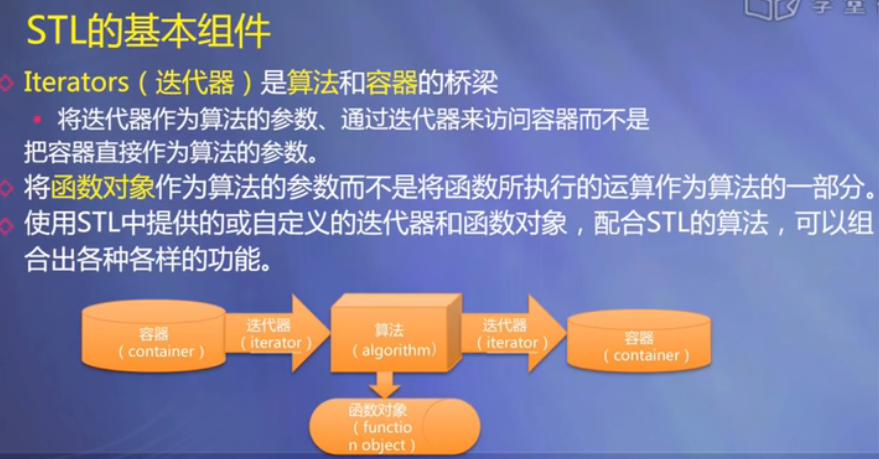
b. Basic operations related to iterators: just remember a few related to pointers
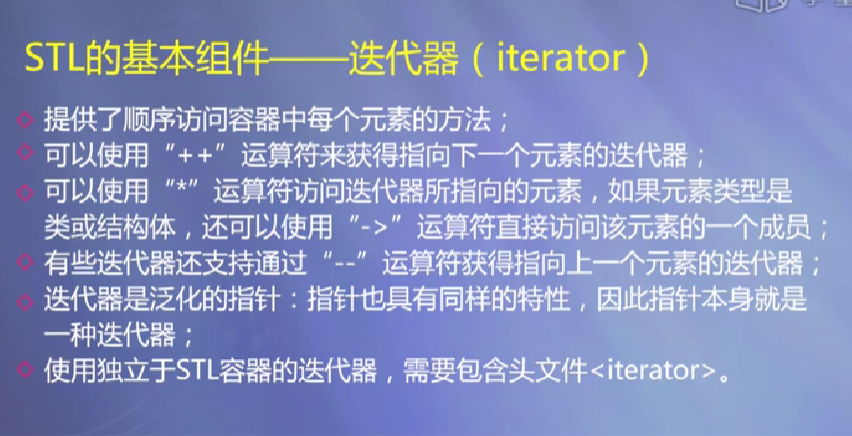
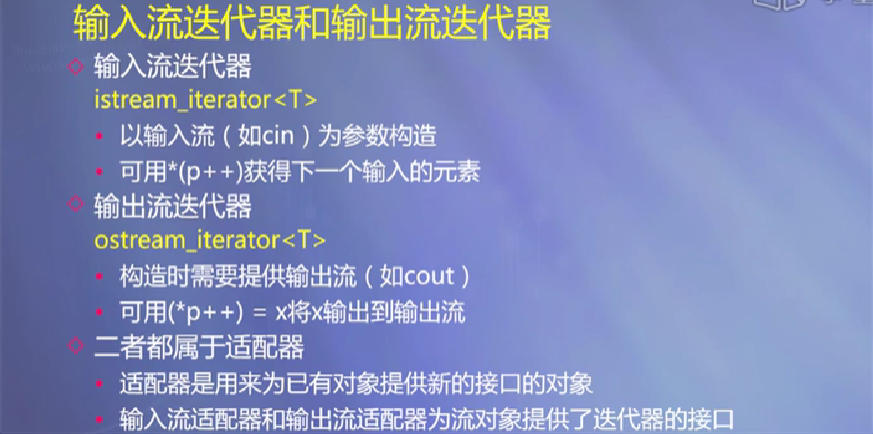
Auxiliary function of iterator
advance(p, n) performs n auto increment operations on p
distance(first,last) calculates the distance between the two iterators first and last, that is, how many "+ +" operations can be performed on first to make first==last
(3) Function object
a. Basic concepts
An object that behaves like a function,
There can be no parameters or several parameters
Its function is to obtain a value or change the state of the operation.
b. Function object provided by STL
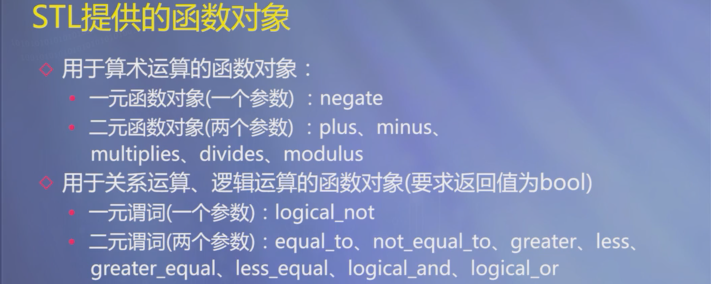
eg. use STL standard function object multiples to realize the concatenation operation of elements
# include <iostream>
# include <utility>
# include <numeric>
# include <functional>
using namespace std;
int main(){
int a[]={1,2,3,4,5};
const int N =sizeof(a)/sizeof(int);
cout<<"The result by multipling all elements in A is"<<" "<<
accumulate(a,a+N,1,multiplies<int>())<<endl;
return 0 ;
}
eg sorts the elements from large to small
# include <iostream>
# include <algorithm>
# include <vector>
# include <functional>
# include <iterator>
using namespace std;
int main(){
int intArr[]={30,90,60,70,50,20,80};
const int N =sizeof(intArr)/sizeof(int);
vector<int> a(intArr,intArr+N);
cout<<"before sorting:"<<endl;
copy(a.begin(),a.end(),ostream_iterator<int>(cout,"\t"));
cout<<endl;
sort(a.begin(),a.end(),greater<int>());
cout<<"after sorting:"<<endl;
copy(a.begin(),a.end(),ostream_iterator<int>(cout,"\t"));
}
(4) Algorithm
a. Algorithm features
As a function template, STL algorithm is universal and independent of data type and container type;
The input data is obtained through the iterator, the data is processed through the function object, and the result is output through the iterator;
b. Algorithm classification
| Algorithm type | Algorithm description | Application examples |
|---|---|---|
| Immutable sequence algorithm | Algorithms that do not directly modify the contents of containers | Find the specified container, compare whether the two sequences are equal, and count the elements |
| Variable sequence algorithm | Modify the object of the container you are working on | Kill, replace and modify the sequence |
| Sorting and search algorithm | There are commonly used sorting and search algorithms | |
| Numerical algorithm | Numerical operation using elements |